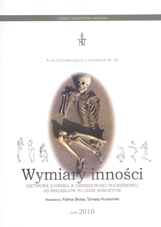Klucze w grobach kobiecych z okresu wpływów rzymskich. Atrybut pozycji społecznej czy wyraz magicznych zabiegów?
Locks and keys found in women graves from the Roman Period. Sign of the social position or result of the cult or magic practices?
Author(s): Katarzyna CzarneckaSubject(s): Archaeology
Published by: Łódzkie Towarzystwo Naukowe
Summary/Abstract: From the Roman Period, to the Early Medieval time, relics of caskets (locks and keys) were deposited in richly furnished women’ graves. Locks and keys were made in different way basing on various construction principles. Most popular were locks with a spring and hook-shaped key. They were simple but very practical. That’s why they were used for a very long time, from the beginning of the Roman Period till the Migration Period (5th century) in the whole Barbaricum. Less frequent were locks with the barbed bolt, invented by Celts, but redesigned by Germanic smiths (these are: locks type Lachmirowice with barb of both sides of the bolt, and a key in a form of a rectangular frame; type Kietrz with loose bolt and forked key; very popular in Merovingian times, locks type Lauffen with bolt attached to the lid, and key with two sideway notches and type Wetzendorf with characteristic mounting with convex cover and simple, bend key). In caskets were kept jewellery and personal equipment. In some graves from the Roman Period were found single keys, without other elements of locks. In the Merovingian period small, not functional keys usually found in pairs (amulets) are most specific indicator of female graves. Remains of caskets and keys were found in richly furnished graves of adult women. They are most often interpreted as indicators of the social status – ‘lady of the house’. Keys symbolised in early medieval times and later an authority over the household gained by marriage. However locked caskets found in graves indicated rather personal belongings more than the whole household. In early medieval German societies personal property of women was very limited. Putting “my own casket” in grave may stress importance of this personal property, “father’s gift” coming from her own family. Keys (and also padlocks found in graves) could also be used as magical or religious symbols – closing one stage of life and entering another (here the Otherworld). Keys were, from the very beginning, linked with sacral sphere as attribute of various goddesses connected with the Underworld like Greek and Roman Hekate, or Celtic Epona. Another symbolic meaning is connected with fertility- “opening” of the womb. Miniature keys were also used as amulets. Also in Christian times small bronze and silver keys were worn as religious souvenirs. Most probably keys found in graves can referred to all this interpretation, not only the social position of the lady of the house.
Journal: Acta Archaeologica Lodziensia
- Issue Year: 2010
- Issue No: 56
- Page Range: 17-26
- Page Count: 10
- Language: Polish

